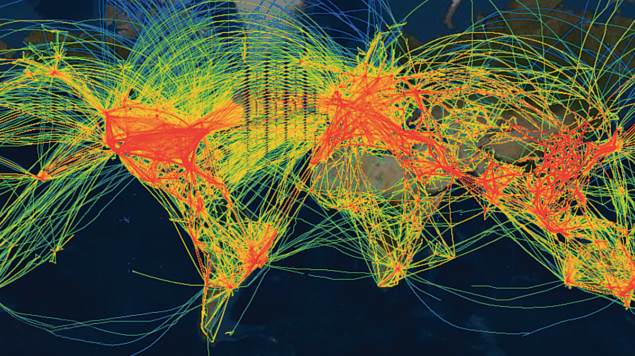Headed by two ATLAS physicists, gluoNNet applies data-mining and machine-learning techniques to benefit wider society, writes Craig Edwards.

Describing itself as a big-data graph-analytics start-up, gluoNNet seeks to bring data analysis from CERN into “real-life” applications. Just two years old, the 12-strong firm based in Geneva and London has already aided clients with decision making by simplifying open-to-public datasets. With studies predicting that in three to four years almost 80% of data and analytics innovations may come from graph technologies, the physicist-based team aims to be the “R&D department” for medium-sized companies and help them evaluate massive volumes of data in a matter of minutes.
gluoNNet co-founder and president Daniel Dobos, an honorary researcher at the Lancaster University, first joined CERN in 2002, focusing on diamond and silicon detectors for the ATLAS experiment. A passion to share technology with a wider audience soon led him to collaborate with organisations and institutes outside the field. In 2016 he became head of foresight and futures for the United Nations-hosted Global Humanitarian Lab, which strives to bring up-to-date technology to countries across the world. Together with co-founder and fellow ATLAS collaborator Karolos Potamianos, an Ernest Rutherford Fellow at the University of Oxford, the pair have been collaborating on non-physics projects since 2014. An example is the THE Port Association, which organises in-person and online events together with CERN IdeaSquare and other partners, including “humanitarian hackathons”.
CERN’s understanding of big data is different to other’s
Daniel Dobos
gluoNNet was a natural next step to bring data analysis from high-energy physics into broader applications. It began as a non-profit, with most work being non-commercial and helping non-governmental organisations (NGOs). Working with UNICEF, for example, gluoNNet tracked countries’ financial transactions on fighting child violence to see if governments were standing by their commitments. “Our analysis even made one country – which was already one of the top donors – double their contribution, after being embarrassed by how little was actually being spent,” says Dobos.
But Dobos was quick to realise that for gluoNNet to become sustainable it had to incorporate, which it did in 2020. “We wanted to take on jobs that were more impactful, however they were also more expensive.” A second base was then added in the UK, which enabled more ambitious projects to be taken on.
Tracking flights
One project arose from an encounter at CERN IdeaSquare. The former head of security of a major European airline had visited CERN and noticed the particle-tracking technology as well as the international and collaborative environment; he believed something similar was needed in the aviation industry. During the visit a lively discussion about the similarities between data in aviation and particle tracking emerged. This person later became a part of the Civil Aviation Administration of Kazakhstan, which gluoNNet now works with to create a holistic overview of global air traffic (see image above). “We were looking for regulatory, safety and ecological misbehaviour, and trying to find out why some airplanes are spending more time in the air than they were expected to,” says Kristiane Novotny, a theoretical physicist who wrote her PhD thesis at CERN and is now a lead data scientist at gluoNNet. “If we can find out why, we can help reduce flight times, and therefore reduce carbon-dioxide emissions due to shorter flights.”
Using experience acquired at CERN in processing enormous amounts of data, gluoNNet’s data-mining and machine-learning algorithms benefit from the same attitude as that at CERN, explains Dobos. “CERN’s understanding of big data is different to other’s. For some companies, what doesn’t fit in an Excel sheet is considered ‘big data’, whereas at CERN this is miniscule.” Therefore, it is no accident that most in the team are CERN alumni. “We need people who have the CERN spirit,” he states. “If you tell people at CERN that we want to get to Mars by tomorrow, they will get on and think about how to get there, rather than shutting down the idea.”
Though it’s still early days for gluoNNet, the team is undertaking R&D to take things to the next level. Working with CERN openlab and the Middle East Technical University’s Application and Research Center for Space and Accelerator Technologies, for example, gluoNNet is exploring the application of quantum-computing algorithms (namely quantum-graph neural networks) for particle-track reconstruction, as well as industrial applications, such as the analysis of aviation data. Another R&D effort, which originated at the Pan European Quantum Internet Hackathon 2019, aims to make use of quantum key distribution to achieve a secure VPN (virtual private network) connection.
One of gluoNNet’s main future projects is a platform that can provide an interconnected system for analysts and decision makers at companies. The platform would allow large amounts of data to be uploaded and presented clearly, with Dobos explaining, “Companies have meetings with data analysts back and forth for weeks on decisions; this could be a place that shortens these decisions to minutes. Large technology companies start to put these platforms in place, but they are out of reach for small and medium sized companies that can’t develop such frameworks internally.”
The vast amounts of data we have available today hold invaluable insights for governments, companies, NGOs and individuals, says Potamianos. “Most of the time only a fraction of the actual information is considered, missing out on relationships, dynamics and intricacies that data could reveal. With gluoNNet, we aim to help stakeholders that don’t have in-house expertise in advanced data processing and visualisation technologies to get insights from their data, making its complexity irrelevant to decision makers.”







